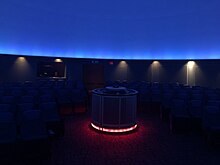The Oregon Museum of Science and Industry is a science and technology museum in Portland, Oregon, United States. It contains three auditoriums, including a large-screen theatre, planetarium, and exhibition halls with a variety of hands-on permanent exhibits focused on natural sciences, industry, and technology. Transient exhibits span a wider range of disciplines.

The Royal Ontario Museum (ROM) is a museum of art, world culture and natural history in Toronto, Ontario, Canada. It is one of the largest museums in North America and the largest in Canada. It attracts more than one million visitors every year, making it the most-visited museum in Canada. It is north of Queen's Park, in the University of Toronto district, with its main entrance on Bloor Street West. Museum subway station is named after it and, since a 2008 renovation, is decorated to resemble the ROM's collection at the platform level.
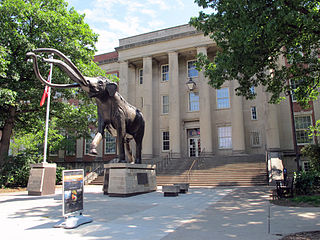
The University of Nebraska State Museum, also known as Morrill Hall, founded in 1871, is a natural history museum featuring Nebraska biodiversity, paleontology, and cultural diversity, located on the University of Nebraska–Lincoln City Campus near the corner of 14th and Vine Streets in Lincoln, Nebraska, United States. The museum houses Mueller Planetarium, a hands-on science discovery center, and the Elephant Hall, where visitors can see the world's largest articulated fossil mammoth among the collection of fossil elephants. Also featured are interactive paleontology exhibits, a dinosaur gallery, ancient life and evolution exhibits, wildlife dioramas, gems and minerals, American Indian and African exhibits, and a temporary exhibit gallery featuring rotating displays on diverse topics including photography, quilts and fine arts.
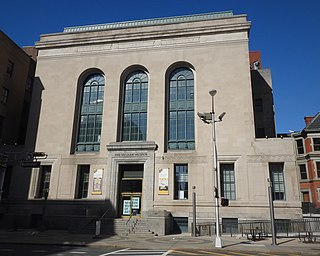
The Newark Museum of Art, formerly known as the Newark Museum, in Newark, Essex County, New Jersey is the state's largest museum. It holds major collections of American art, decorative arts, contemporary art, and arts of Asia, Africa, the Americas, and the ancient world. Its extensive collections of American art include works by Hiram Powers, Thomas Cole, John Singer Sargent, Albert Bierstadt, Frederick Church, Childe Hassam, Mary Cassatt, Edward Hopper, Georgia O'Keeffe, Joseph Stella, Tony Smith and Frank Stella.

The Museum of Science (MoS) is a nature and science museum and indoor zoological establishment located in Science Park, a plot of land in Boston and Cambridge, Massachusetts, spanning the Charles River. Along with over 700 interactive exhibits, the museum features a number of live and interactive presentations throughout the building each day, along with scheduled film showings at the Charles Hayden Planetarium and the Mugar Omni Theater. The Museum is a member of the Association of Science and Technology Centers (ASTC) and the American Alliance of Museums (AAM). Additionally, the Museum of Science is an accredited member of the Association of Zoos and Aquariums (AZA), being home to over 100 animals, many of which the museum gained after they were surrendered, confiscated, rescued or rehabilitated.

Carnegie Museums of Pittsburgh is a nonprofit organization that operates four museums in Pittsburgh, Pennsylvania, United States. The organization is headquartered in the Carnegie Institute and Library complex in the Oakland neighborhood of Pittsburgh. The Carnegie Institute complex, which includes the original museum, recital hall, and library, was added to the National Register of Historic Places on March 30, 1979.

The Saint Louis Science Center, founded as a planetarium in 1963, is a collection of buildings including a science museum and planetarium in St. Louis, Missouri, on the southeastern corner of Forest Park. With over 750 exhibits in a complex of over 300,000 square feet (28,000 m2), it is among the largest of its type in the United States.

The Fleet Science Center is a science museum and planetarium in Balboa Park in San Diego, California. Established in 1973, it was the first science museum to combine interactive science exhibits with a planetarium and an IMAX Dome (OMNIMAX) theater, setting the standard that most major science museums follow today. It is located at the east end of the El Prado Drive walkway, next to the Bea Evenson Fountain and plaza in central Balboa Park.

Telus World of Science Edmonton (TWOSE) is a broad-based science centre in Edmonton, Alberta, Canada, operated by the (non-profit) Edmonton Space & Science Foundation. The centre is located on the southwest corner of Coronation Park in the neighborhood of Woodcroft. The science centre houses 144,430 sq. ft. of public space and is the largest science centre in Western Canada. It is currently a member of both the Association of Science-Technology Centers (ASTC) and the Canadian Association of Science Centres (CASC).

Science Museum Oklahoma is a science museum located in Oklahoma City, Oklahoma. The museum features several notable attractions, including the new Love's Planetarium, the International Gymnastics Hall of Fame, and various specialized galleries. With a facility spanning over 390,000 square feet, it ranks among the largest science museums in the nation. Originally established as the Kirkpatrick Planetarium in 1958, the museum underwent significant expansions in 1980, 1985, 2000, and 2007.

The Houston Museum of Natural Science is a natural history museum located on the northern border of Hermann Park in Houston, Texas, United States. The museum was established in 1909 by the Houston Museum and Scientific Society, an organization whose goals were to provide a free institution for the people of Houston focusing on education and science. The museum complex consists of a central facility with four floors of natural science halls and exhibits, the Burke Baker Planetarium, the Cockrell Butterfly Center, and the Wortham Giant Screen Theatre. In 2022, the museum received 1,520,000 visitors, making it seventh on the List of most-visited museums in the United States, and was the third most-visited U.S. science museum. Much of the museum's popularity is attributed to its large number of special or guest exhibits.

The Boonshoft Museum of Discovery is a children's museum, science and technology center and zoo in Dayton, Ohio, United States that focuses on science and natural history. Exhibits include an extensive natural history collection as well as maintaining a collection of live animals native to Ohio and abroad. Educational outreach extends to the community by providing in-school programming and on-site special programs. SunWatch Indian Village and Fort Ancient are the sister sites to the museum.
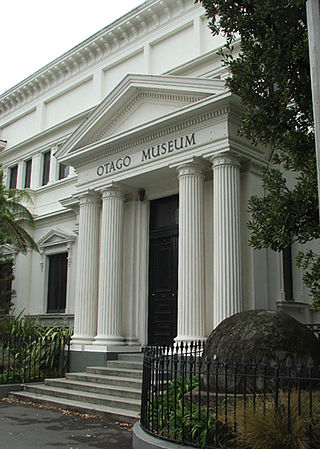
Tūhura Otago Museum, located near the city center of Dunedin, New Zealand, adjacent to the University of Otago campus, is one of the country's largest museums and a prominent attraction in the city. The museum's extensive collections encompass natural science specimens and humanities artifacts from the Otago region and around the world, which are featured in its long-term gallery displays. A notable feature of the museum is its interactive science center, which includes an immersive tropical rainforest butterfly house. In 2022, the museum was officially renamed Tūhura Otago Museum, incorporating the Māori name "Tūhura," meaning "to discover, investigate, and explore."

The New Mexico Museum of Natural History and Science is a natural history and science museum in Albuquerque, New Mexico near Old Town Albuquerque. The Museum was founded in 1986. It operates as a public revenue facility of the New Mexico Department of Cultural Affairs.

The Clay Center in Charleston, West Virginia, is a 240,000-square-foot (22,000 m2) facility dedicated to promoting performing arts, visual arts, and the sciences.
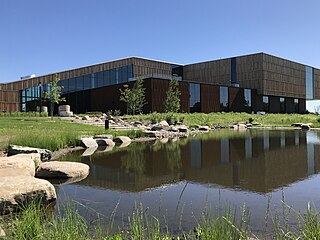
The Bell Museum, formerly known as the James Ford Bell Museum of Natural History, is located at the University of Minnesota's Saint Paul campus. The museum's current location on the Saint Paul campus opened in 2018. The Minnesota wildlife dioramas focus on animal specimens native to the state. The museum also houses the digital Whitney and Elizabeth MacMillan Planetarium. The museum is part of the university's College of Food, Agricultural and Natural Resource Sciences. The museum's former location on University of Minnesota's Minneapolis campus closed in January 2017.

The Cox Science Center and Aquarium, formerly the South Florida Science Center and Aquarium, is a science museum located in West Palm Beach, Florida. Founded in 1959, the goal of the organization is to open every mind to science through the strategic programming of interactive exhibits and engaging community-based camps and events. The Cox Center has expanded since its creation and now houses over 50 hands-on exhibits, a planetarium, a 3000 square foot aquarium, a miniature golf course, and a large exhibit space that displays a temporary travelling exhibit. The Cox Center is a member of the Association of Science-Technology Centers program, which offers a membership that is redeemable at other ASTC science and technology centers around the world. The Cox Center occupies Dreher Park alongside the Palm Beach Zoo and offers deals for entrance into both facilities.

The New Jersey State Museum is located at 195-205 West State Street in Trenton, in the U.S. state of New Jersey. The museum's collections include natural history specimens, archaeological and ethnographic artifacts, and cultural history and fine art objects. Exhibitions, educational activities, research programs, and lectures are also offered. The museum, a division of the New Jersey Department of State, includes a 140-seat planetarium and a 384-seat auditorium.

Nehru Centre is a centre to promote the teachings and ideals of the first Prime Minister of India, Jawaharlal Nehru, through educational and cultural programmes in the city of Mumbai, India. The Centre organises scientific, cultural and educational activities.

The Stamford Museum & Nature Center, located in Stamford, Connecticut, is an art, history, nature, and agricultural sciences museum. The property covers 118 acres beginning about half a mile north of the Merritt Parkway. It was originally a private estate.



